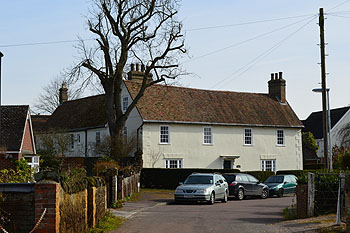Home Farm Potton

Home Farmhouse February 2013
Home Farmhouse was listed by the former Department of Environment in January 1976 as Grade II, of special interest. The house has origins in the 17th century though re-worked in the two succeeding centuries. The main block is timber-framed with colourwashed plaster over the exterior. There is a 19th century addition at the rear in colourwashed brick. Both structures have clay tiled roofs. The early block has two storeys and attics and the later part just two storeys.
In 1908 the farm, together with Cross Roads Farm, was owned by Henry Smith of Potton Manor and had a total of 291 acres, 3 roods, 3 poles [X726/1]. Smith willed the farms to spinsters Lucina Elizabeth Smith of Brighton, spinster, Emilie Gladys Lind Smith of Potton as trustees for sale. He died in 1915 and twenty years later Lucina and Emilie, together with Grace Eugenia Smith of Potton Manor, tenant for life by the will of George Smith, conveyed the farms to Percy Malcolm Stewart along with cottages, Spencers Farm of 241 acres 3roods 3ppoles and 1acre 26 poles of land with a sand pit. Stewart was chairman of London Brick Company and responsible for building Stewartby. He immediately gave all the land to the Land Settlement Association Limited.
The Rating and Valuation Act 1925 specified that every building and piece of land in the country was to be assessed to determine its rateable value. Potton, like much of the county, was assessed in 1927. The valuer visiting Home Farmhouse found that it was now separated from the farm itself. The property was, of course, still owned by the Misses Smith and was occupied by Augustine Ambrose Comerford who, Kelly’s Directory for Bedfordshire for 1928 tells us, was a veterinary surgeon. No rent is given in the valuer’s notebook.
The ground floor comprised: three reception rooms; a kitchen (“no scullery”) and a larder. The first floor contained six bedrooms but no bathroom and the second floor has three small, disused attics. Outside stood a one-car wood and tiled garage. The valuer noted: “Former two loose boxes now partitioned off into vet’s kennels”. There was also a brick and tiled store room with a loft over, a brick and slate dispensary and a “large garden”.
The farm itself [DV1/H9/71b] contained the following buildings: a brick, wood and slated hen house; a seven horse stable with a loft over and chaff house; two wood and slate barns; a wood and slate three bay open shed, loose box and four bay open shed; a wood and slate four bay open shed, store and six bay open shed; two wood and slate pigsties; two wood and slate barns; a wood and slate five bay cart shed; two wood and tiled stores; a brick and tile boiling house; two brick and tile five bay open sheds; a wood, tile and corrugated iron barn and chaff house; a wood and tile hen house and three pigsties; a brick, wood and slate granary with a loft over; a brick and slate for stall stable; a brick, wood and slate garage with a loft over; a wood and slate pigsty and three bay open shed; a brick, tile and slate malting used as a potato store with a loft over; a brick and tile three bay open shed; a brick and tile malting with a loft over used as a potato store; a brick and thatch potato store; a brick, wood and slate potato store with a loft over and a wood and tile three bay open shed in a meadow.
In 1950 the Land Settlement Association conveyed the farms to the Ministry of Agriculture, Fisheries and Food [X726/8]. In 1976 plans were submitted [PL/P/MB76/1122] for approval to build the housing development around the farmhouse which is in existence today [2013].